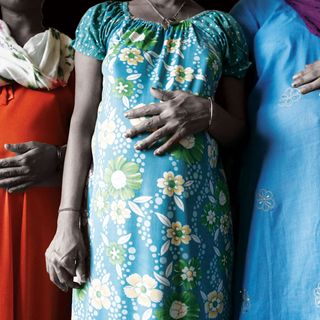
AIIMS Fire Is Symbolic of India’s Flailing Public Health Care System
Indian public health care runs on luck and heroism — two finite resources.

At 4:50 p.m. on 17 August 2019, the alarm was raised at the All India Institute of Medical Sciences (AIIMS) — a fire had broken out in the building that houses the Emergency Department.
The news was quick to catch up on the incident, repeating a fortunate phrase: “luckily no casualties reported.”
Luck. Luck is what our health system is running on – luck and heroism, with healthcare staff working like firefighters in a system that is constantly under-resourced, understaffed, and overwhelmed.
At the start, the fire seemed manageable; it was limited to the second or third floor, but then suddenly the flames were touching the fifth floor. As the fire raged, one felt that the building might collapse, but it remained standing. Healthcare staff in public hospitals face a similar crisis most days, putting out one ‘fire,’ only to have another one staring at them. Given this, it is remarkable that the health system doesn’t totally collapse into chaos.
A system running on luck
Have you ever been to a public hospital? If not, then do visit a few public hospitals. You will see confusion, endless waiting, shortages of medicines and supplies, broken beds, two patients on one bed, and some lying on the floor, non-functional equipment, patients holding medication bottles with no place to hang them, dirty linen — this is, perhaps, what a hospital looks like in a city at war. This is not what hospitals in the capital city of India should look like in the year 2019. But they do.
Yes, thousands of patients get care every day and go home healed. A decade ago I was working as an intern at a public hospital in Delhi when a patient was admitted with a massive, infected abdominal wound. For a month, every day, doctors and nurses painstakingly cleaned the wound while the man remained bedridden. I never thought the wound would heal, given its size. However, six months later, the same young man was walking normally down a hospital corridor. He had recovered. His mother was smiling.
But luck is a finite resource, and even heroes cannot fight an interminable battle.
Leaders’ lip service to public healthcare mirrors the news’ intermittent reassurances about the AIIMS fire being under control when it was actually spreading to higher floors.
For every story like the young man’s, countless others face interminable waits for appointments, months spent in limbo for basic surgeries, precious money spent on purchasing medicines, equipment, and drugs that are out of stock at the hospital, and so many stories of frustration and wasted months, years, lives.
Harder than the lack of good services is the lack of empathy. Among the many committed, hard-working and kind doctors, nurses and allied health staff, there are also those who are rude — some downright abusive — toward patients, their families, and even towards other staff and juniors. This culture of indifference can make a stay at government hospitals a nightmare for patients and families.
It is at the public hospital that the great Indian healthcare divide becomes visible. Those who can afford private hospitals, don’t come to a public hospital; thus, they have no insight into how the other half (or more) of the Indian public gets its healthcare. Dignitaries and politicians, who receive care at public hospitals, may not realize they have a markedly different experience than the common patient.
Related on The Swaddle:
AIIMS’ Fake Doctor Exemplifies Flaws in India’s Health Care
Not that we can rely on private hospitals either. These hospitals are incentivized to maximize their profits and minimize their risk. Incidents of poor quality care, harm and error are plenty at private hospitals, too. Unnecessary interventions, which have no basis in medical evidence but minimize the hospital’s own risk, are recommended even if they drive up patients’ expenditures. Private hospitals also do not publicly share their data on care outcomes or hospital infection rates, so they are not held accountable for good clinical care in any way.
No committed fixes
The typical government reaction to any incident, like the recent fire, is an ‘inquiry,’ a superficial inquiry that will usually lead to a scapegoat health professional who is not actually responsible. Punishment is meted out, and the case is closed. Then, the same crisis repeats because the real issues were never identified and addressed.
The general public is incredulous that this fire could have happened at AIIMS, India’s “most premier” institution, “most prestigious.” People who have likely never been to AIIMS find it incredible. Staff at all public hospitals are familiar with the squeezing out of any available corner of aging buildings to meet the ever-increasing patient census. Those who know AIIMS have witnessed its tangle of complex labyrinths emerge over the years. This constant space crunch will put any structure at risk of a fire. This incident is not a surprise; it is an inevitability.
What is surprising is that this is supposedly the biggest fire at AIIMS in living memory — a fire that was immediately responded to and from which patients were safely evacuated. A fire without any injuries or casualties. This is the result of luck and heroism by hospital staff and firefighters. It is not (the assumption of) good facilities that make an institution prestigious; it is the ability of the staff to respond to such a crisis effectively that makes it prestigious.
Amid the chaos of the fire, a woman required an urgent cesarean section. Due to the fire, the usual operating theatres could not be used. She was moved to the operation theatre at the Dr. Rajendra Prasad Centre for Ophthalmic Sciences, another building at AIIMS. The staff orchestrated the transfer of the patient, necessary equipment and an emergency cesarean section in a unit designed only for eye surgeries, all while parallel evacuation efforts were underway. The woman safely gave birth to a healthy baby girl — the first baby ever delivered at the eye center!
It is time to support our healthcare workers and to quit our reliance on luck and heroism alone.
For decades the leaders of this country have paid lip service to public healthcare, giving token reassurances and short-sighted programs. These platitudes mirror the intermittent reassurances we kept hearing in news reports about the AIIMS fire being under control when it was actually spreading to higher floors.
The situation is not going to change unless we challenge the great Indian healthcare divide, that gap between the half of India oblivious to the obstacles faced by the other half in receiving healthcare. The onus is on all of us to demand increased public spending on healthcare. It is not sufficient to cover people’s healthcare expenses through public or private insurance schemes, we also need to demand a major upgrade of public hospitals and health centers to meet modern-day standards.
We must realize that disrespectful behavior by healthcare staff is not simply an individual failing, it is the failing of our educational system. We must also demand better models of medical education — education that doesn’t just focus on rote learning but trains people in communication, empathy and management skills, so medical professionals can become change-makers rather than survivors.
And, we must question why a humungous residential and commercial complex was developed in East Kidwai Nagar in the vicinity of AIIMS, which could and should have instead been redesigned to provide medical services and reduce congestion in neighboring, overcrowded hospitals. Instead, the new development will worsen shortages of essentials like water and increase traffic congestion around two major hospitals – AIIMS and Safdarjung.
India has sent a second mission to the moon. It is time to chase not just the stars in outer space but also to turn our lens closer to home. It is time to focus on a mission to fix our broken hospitals and our relic of a medical education system. It is time to support our healthcare workers and to quit our reliance on luck and heroism alone.
Sonali Vaid is a physician with a Masters of Public Health from the Harvard School of Public Health. She is working to improve the quality and safety of healthcare delivery. She has a decade of experience in global health with various international organizations in India, South Asia, Africa, and the United States. She also believes in the power of artistic pursuits to transform individuals, organizations, and societies. She tweets at @sonalivaid.
Related


GoI Reinforces Heterosexual Definition of Family With Surrogacy Bill
